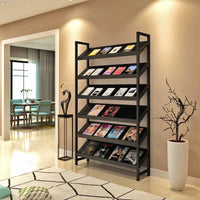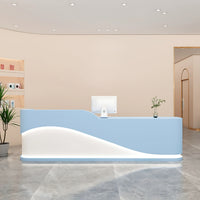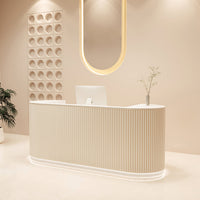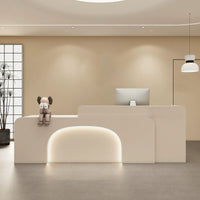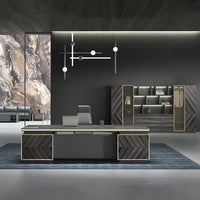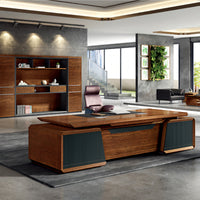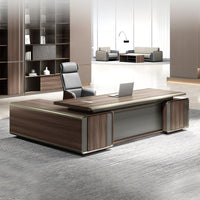How Many Chairs Can You Fit at a Conference Table?
kaguyasuContent Menu
● Understanding the Basics
>> Why Chair Capacity Matters
>> Key Factors Affecting Chair Capacity
● Table Size and Seating Capacity
>> Standard Table Sizes and Their Seating
>> How to Calculate Chair Capacity
● The Impact of Table Shape
>> Rectangular Tables
>> Boat-Shaped and Oval Tables
>> Round Tables
>> U-Shaped and V-Shaped Tables
● Room Size and Layout Considerations
>> Minimum Room Size Requirements
>> Calculating Table Size for Your Room
>> Other Room Features
● Chair Size and Style
>> Standard Chair Dimensions
>> Chair Style Impacts
● Special Considerations
>> Social Distancing and Personal Space
>> Technology and Accessories
>> Meeting Type
● Practical Examples
>> Example 1: Small Conference Room
>> Example 2: Medium Conference Room
>> Example 3: Large Conference Room
● Tips for Maximizing Comfort and Efficiency
● Frequently Asked Questions
>> 1. How do I determine the right size conference table for my room?
>> 2. How much space should I allow per person at a conference table?
>> 3. Can I fit more chairs if I use armless or smaller chairs?
>> 4. What is the best table shape for maximizing seating?
>> 5. How do I accommodate technology and equipment at my conference table?
>> 6. What if my room has columns or unusual features?
>> 7. Is it better to have a larger table with fewer chairs or a smaller table with more chairs?
Creating the perfect conference room is a blend of art and science. One of the most common—and deceptively complex—questions is: How many chairs can you fit at a conference table? The answer is not as straightforward as it might seem. It depends on several factors, including table size and shape, chair dimensions, room size, and even the nature of your meetings. This comprehensive guide will explore all these variables, providing practical advice and real-world examples to help you plan your ideal conference space.

Understanding the Basics
Why Chair Capacity Matters
The number of chairs you can fit at a conference table directly impacts the functionality and comfort of your meeting space. Too many chairs can make the room feel cramped, hinder movement, and reduce productivity. Too few, and you risk not accommodating all participants, leading to awkward seating arrangements or even exclusion.
Key Factors Affecting Chair Capacity
- Table size and shape
- Room dimensions and layout
- Chair size and style
- Allowance for walkways and accessibility
- Storage and additional furniture
- Meeting type and required personal space
Table Size and Seating Capacity
Standard Table Sizes and Their Seating
Conference tables come in various sizes. Here is a breakdown of common table sizes and their typical seating capacities:
| Table Length | Table Width | Seating Capacity |
|---|---|---|
| 6 ft (72") | 4 ft (48") | 4-6 |
| 8 ft (96") | 4 ft (48") | 6-8 |
| 10 ft (120") | 4 ft (48") | 8-10 |
| 12 ft (144") | 4 ft (48") | 10-12 |
| 14 ft (168") | 4 ft (48") | 12-14 |
| 16 ft (192") | 4.8 ft (58") | 14-16 |
| 20 ft (240") | 4.8 ft (58") | 18-20 |
| 24 ft (288") | 4.8 ft (58") | 22-24 |
These numbers reflect a range from comfortable to full seating. The lower end of the range allows for more personal space, while the higher end is more compact.
How to Calculate Chair Capacity
A general guideline is to allow at least 30 inches of table perimeter per person for standard comfort. For more spacious seating, 36 to 42 inches per person is recommended. Multiply the number of people by your desired space per person to determine the required table perimeter.
For example, if you want to seat 10 people comfortably with 36 inches each:
- 10 people x 36 inches = 360 inches of perimeter (or 30 feet).
For rectangular tables, divide the perimeter between the sides and ends to determine how many chairs fit on each side.
The Impact of Table Shape
Rectangular Tables
Rectangular tables are the most common and provide the most efficient seating. Chairs are placed along each side and at the ends. For example, a 10-foot rectangular table typically seats eight to ten people, with four chairs on each side and one at each end.
Boat-Shaped and Oval Tables
Boat-shaped tables are wider in the middle, offering a bit more space per person and a less formal look. They generally seat the same number as rectangular tables of the same length but may feel less cramped.
Oval tables encourage more interaction and can seat the same number as rectangular ones but may offer slightly less elbow room at the ends.
Round Tables
Round tables are best for smaller groups. A 5-foot round table seats six to eight, while a 6-foot round table can accommodate up to ten. The lack of corners means everyone is equally positioned for conversation.
U-Shaped and V-Shaped Tables
These configurations are ideal for presentations and discussions where everyone needs a clear view of a focal point. Seating is limited to the outer perimeter, reducing the total number of chairs compared to a similarly sized rectangular table.
Room Size and Layout Considerations
Minimum Room Size Requirements
The size of your conference room determines how large a table you can fit and, consequently, how many chairs you can place. Always allow for adequate walkways and space behind chairs for people to move comfortably.
A good rule of thumb is to leave at least 56 inches between the wall and the back of a chair for comfortable movement, 32 inches to rise from the table, and a minimum of 24 inches to walk behind seated participants. The absolute minimum is 48 inches for sideways movement.
Calculating Table Size for Your Room
To determine the largest table your room can accommodate:
- Measure the length and width of your room.
- Subtract 10 feet from the length and 6 feet from the width to allow for walkways and chair clearance.
- The remaining dimensions are the maximum size for your table.
For example, if your room is 22 feet long and 14 feet wide:
- Table length: 22 - 10 = 12 feet
- Table width: 14 - 6 = 8 feet
A 12-foot by 4-foot table would fit comfortably, seating 10-12 people.
Other Room Features
Consider the location of doors, windows, columns, and storage units. These can impact where you place your table and how many chairs you can fit. Allow extra space for any credenzas or storage cabinets, typically 20-24 inches deep, and remember to account for door swing clearances.
Chair Size and Style
Standard Chair Dimensions
Most conference chairs are about 20-24 inches wide. Allow at least 30 inches per person for standard comfort, but increase this if your chairs are wider or have armrests.
Chair Style Impacts
- Armless chairs allow for tighter spacing.
- Chairs with arms require more space.
- Executive chairs are often larger and need more room.
Choose chairs that match the scale of your table and the intended comfort level for your meetings.
Special Considerations
Social Distancing and Personal Space
In recent years, many organizations have increased the space per person at conference tables for health and comfort reasons. For social distancing, allow at least 42-48 inches per person.
Technology and Accessories
If your meetings require laptops, microphones, or other equipment, you may need to reduce the number of chairs to ensure everyone has enough workspace.
Meeting Type
The nature of your meetings affects chair capacity. For collaborative sessions, more space per person is beneficial. For brief, informational meetings, you can seat more people at the same table.
Practical Examples
Example 1: Small Conference Room
- Room size: 15' x 12'
- Table: 6' x 4'
- Chairs: 4-6
This setup allows for comfortable movement and is ideal for small team meetings.
Example 2: Medium Conference Room
- Room size: 20' x 12'
- Table: 12' x 4'
- Chairs: 10-12
This configuration suits most standard boardrooms, balancing capacity and comfort.
Example 3: Large Conference Room
- Room size: 30' x 14'
- Table: 20' x 4.8'
- Chairs: 18-20
A large table like this is perfect for executive meetings or large group discussions.
Tips for Maximizing Comfort and Efficiency
- Always prioritize comfort over maximum capacity.
- Test your layout with actual chairs before finalizing your arrangement.
- Consider flexible seating options, such as stacking or nesting chairs for overflow.
- Use visual aids or software to sketch your room and test different layouts.
- Consult with furniture professionals for custom solutions.
Frequently Asked Questions
1. How do I determine the right size conference table for my room?
Measure your room and subtract 10 feet from the length and 6 feet from the width to allow for walkways and chair clearance. The remaining space is your maximum table size.
2. How much space should I allow per person at a conference table?
Allow at least 30 inches per person for standard comfort. For more spacious seating, 36-42 inches is ideal. For social distancing, allow 42-48 inches per person.
3. Can I fit more chairs if I use armless or smaller chairs?
Yes, armless or narrower chairs allow for tighter spacing, but be careful not to compromise comfort or accessibility.
4. What is the best table shape for maximizing seating?
Rectangular tables are the most efficient for maximizing seating. Boat-shaped and oval tables are similar but may offer slightly less elbow room at the ends.
5. How do I accommodate technology and equipment at my conference table?
If your meetings require laptops, microphones, or other equipment, reduce the number of chairs to ensure everyone has enough workspace.
6. What if my room has columns or unusual features?
Plan your layout carefully, considering all architectural features. You may need a custom-shaped table or flexible seating arrangements.
7. Is it better to have a larger table with fewer chairs or a smaller table with more chairs?
Prioritize comfort and functionality. A slightly smaller table with fewer, well-spaced chairs is usually better than a larger table that feels cramped.

[1] https://www.ambiencedore.com/conference-room-planning-guide/
[2] https://madisonliquidators.com/conference-table-dimensions
[3] https://www.custom-conference-tables.com/about-tables/size-seating-guide/number-of-seats/
[4] https://www.officechairsusa.com/seating/conference-room-seating/
[5] https://www.hon.com/tables/conference-tables
[6] https://www.cnblogs.com/weiqinglan/p/5852405.html
[7] https://www.furniturewholesalers.com/conference-room-chairs
[8] https://www.aip.org/sites/default/files/china/pdfs/ease_writing_guide.pdf
Hot Tags: China, Global, OEM, private label, manufacturers, factory, suppliers, manufacturing company



